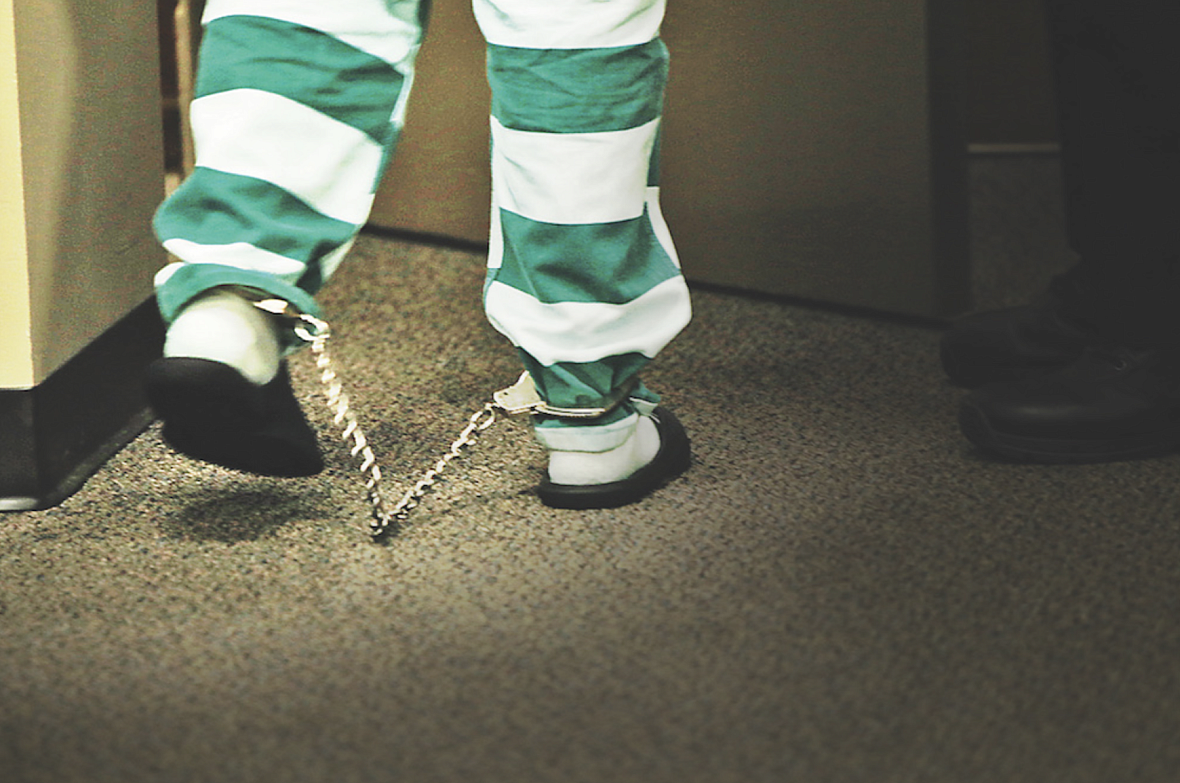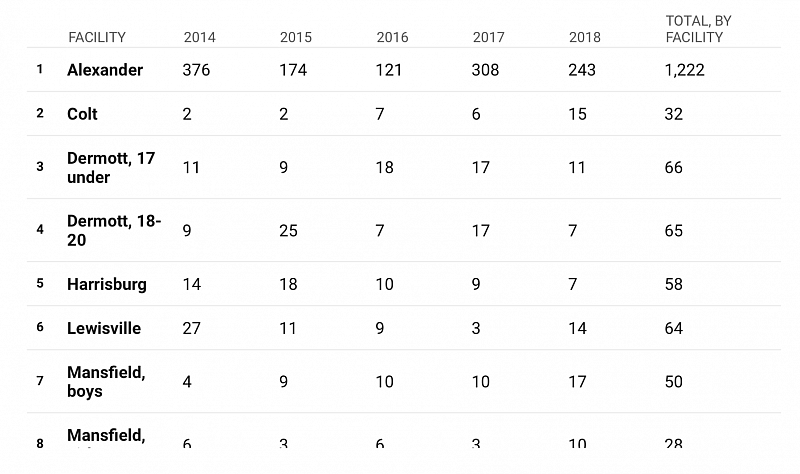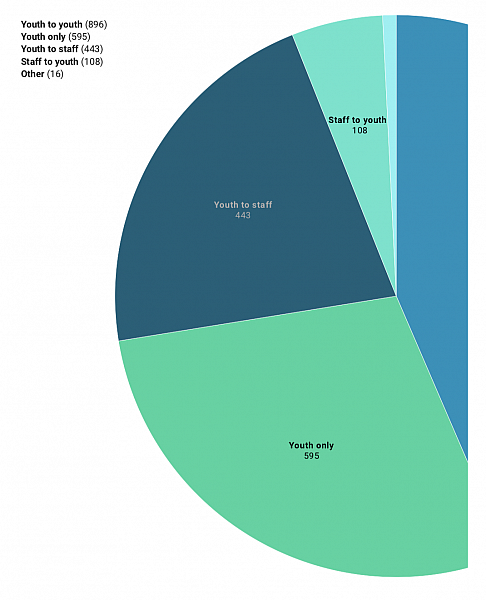"Juvie: Lost Time," Part 3:"Youth advocates, state disagree on need for independent oversight
Support for Curcio’s reporting on this project also came from the Fund for Journalism on Child Well-Being, a program of the USC Annenberg Center for Health Journalism at the University of Southern California.
Other stories in this series include:
As kids languish in lockups, rehabilitation chances fade
Youth advocates, state disagree on need for independent oversight
Youth miss out on school, mental services in lockups
After scandals, 1 Arkansas youth jail to stop incarcerations
Promise of family services misses the mark in Arkansas
Youth jail to stop incarcerations
Files reveal dozens of violations by firm set to manage Arkansas' youth prisons

Tracy Reed worried about her son for almost 700 days while he was incarcerated in Arkansas’ youth lockups after an arrest for burglary.
The 15-year-old was transported from jail to jail. Guards placed him in chokeholds and slammed him into walls out of view of cameras, the Newport mother said. He spent nearly a month in solitary connement.
He didn’t seem to get better, Reed said. He threatened to kill himself.
When he nally returned home in June of 2017, a sense of guilt kept her isolated from him.
“Why’d you let it go so far?” he asked her. “Why did you let this happen to me?”
Since her son’s incarceration, Reed reads everything she can nd on national and statewide juvenile-justice policies. A stack of notebooks sits in her bedroom, lled with the information she’s learned. She recites case after case of maltreatment that’s
been reported over the years at the state youth prison near Alexander, where her son spent nearly two years.
“Every time I read something in the newspaper, about something bad that was uncovered in juvie, I would cry,” she said. “I felt like I was reading something about him. He’s a statistic now.
“What I can’t believe is how they can get away with hurting the kids,” she added. “The state relies on people not knowing what’s happening in there.”
Abuses inside youth lockups often come to public attention only when parents like Reed, formerly incarcerated children and others speak out.
Arkansas youth prison assaults, 2014-18
The state's juvenile lockups reported a total of 1,585 incidents of assaults and physical abuse between 2014 and 2018, records show. The Arkansas Juvenile Assessment and Treatment Center, the state's largest youth lockup in Alexander, reported the most incidents during that time.

The Arkansas Division of Youth Services won’t disclose individual reports about violence or other abuses inside its youth prisons. In rejecting requests under the state’s public records law, division representatives say that any record of an incident, even with names and facility locations redacted, can expose the identity of the youth involved.
The agency also no longer discloses incidents of abuse or neglect or employee misconduct in its annual and quarterly reports to legislators.
The agency still collects the information, and in response to a state Freedom of Information Act request, it told the Arkansas Democrat-Gazette that there were a total of 324 incidents of assault and physical abuse at all youth prisons in 2018, up from a low of 188 in 2016.
The Youth Services Division, overseen by the Department of Human Services, has managed six state youth lockups since January 2017 and has oversight authority of 14 county-run detention centers. Before 2017, two nonprots managed the state youth prisons.
“Unfortunately, there have been incidents at facilities,” said department spokesman Amy Webb. “We take those very seriously because it is important that youth in our care always feel safe. When situations have arisen, they have been isolated and addressed as soon as we are made aware of them.”
Experts say Arkansas needs an independent body with the authority to conduct routine and surprise inspections of the state’s youth prisons and to report its ndings. Advocates say monitors that are independent of the agencies that oversee juvenile facilities help curb instances of neglect or abuse.
States with independent monitors, such as Illinois, Kentucky, Louisiana, Mississippi, Texas, Maryland, Connecticut and New York, see positive change, media and government reports show.
Bad facilities were closed, bad employees red, youths reported fewer incidents of physical abuse.
Independent monitors also inuence changes in policies affecting incarcerated kids, including an end to abuses of solitary connement and pepper-spraying, and increased family visitations.
Arkansas ofcials have not followed through on calls for independent oversight of the state’s youth prisons.
Legislation passed last month promises sweeping “juvenile justice reform,” but contains no provision for a separate panel that would scrutinize what happens to kids behind bars. The new law focuses more on diverting children from prison and shortening their stays behind bars.
“Under the new juvenile justice initiative, the Youth Services Division will have the rst responsibility to monitor, inspect and assure compliance over the private contractor [running the facilities], who will also have clear guidelines and requirements to follow,” Gov. Asa Hutchinson said.
“The option of an independent monitor should only be considered down the road if the reforms currently being developed are insufcient for the well-being of our youth.”
The Youth Services Division recently created “monitoring teams” made up of agency employees.
The teams are supposed to “ensure transparency at all levels of facility operations” — including living conditions, incident response and quality of services — and to “strengthen the grievance procedures for youth and their advocates, and to ensure youth and families know their rights,” said Marci Manley, a spokesman for the Department of Human Services, which oversees the division.
Little Rock attorney Amy Lafont, who works with families and children entangled in the juvenile justice system, says the agency oversight falls short.
The division’s policy changes fail to create a robust accountability and monitoring system needed to protect the rights of incarcerated youths, she said.
Lafont recently represented a teenager who was struck by a guard at the Alexander lockup in December 2016. Garland County juvenile court lings allege that the facility staff attempted to cover up the incident by placing the teen in solitary connement for several days and falsifying paperwork. State police investigated the incident, which was caught on surveillance video, and the guard was red, court records show.
The incident occurred after state ofcials said staff members had added and repositioned cameras to eliminate “dead zones,” areas not captured by surveillance, where kids often say they’re assaulted by other child inmates or guards.
“Who is looking at what happens to children in juvie?” Lafont asked. “How are they talked to? How are they treated? Who is advocating for them? Where is the real oversight? What else is going on that we never uncover?
“The [concerns] that I’m raising, nobody is telling me that these aren’t very serious issues. ... But who is being held responsible?” she asked. “No one.”
Harley
Harley swung his foot over the awning, then perched there, at least 10 feet from the ground.
A crowd of other Dermott Juvenile Correctional Facility inmates stood below him. Some watched as he posed for the camera, his face serious. Others seemed unfazed by the teen’s climb toward the top of one of the youth prison’s buildings.
A surveillance camera hung just a foot away, almost straight line of sight to where the boy crouched.
But this scene was captured by a cellphone camera and later posted on a private Instagram account in August.
A few months later, another photo surfaced on the social media platform: It showed Harley in the recreation yard next to the Dermott prison’s outdoor basketball court, taking a drag from a cigarette.
Other Instagram photos showed him standing in his cell, grafti along the door and walls; in front of a mirror above a bathroom sink, next to another teen taking a photo of his own reection in the mirror; and with other boys in Dermott huddled together outdoors, the tall razor-wire perimeter fence behind them and the Delta Regional Unit, an adult state prison, a few hundred feet away.
Youths at the Dermott lockup, as well as the state’s other ve juvenile prisons, are supposed to be supervised all day. They’re not supposed to have cellphones or cigarettes.
Arkansas youth prison population, by race
This map shows the percent of committed Arkansas youths who are of color, compared to the state's total youth prison population between 2014 and 2018. Circuit judges ultimately make the decision whether to commit youths to juvenile lockups.

The state says it maintains a ratio of at least one staff person to eight inmates at all facilities during the day, and one to 10 at night.
But leaked photos like Harley’s indicate that the facility staff neglects to provide proper supervision and that contraband items are available.
Webb acknowledged that the facility had “contraband issues” at the time, especially cellphones.
In response, the Youth Services Division required that employees and visitors be searched, and brought in trained dogs to nd any drugs. The last drug search took place in January and yielded no results, she said.
Webb also said workers placed fencing around the air conditioning unit that teen inmates were climbing to get to the roof.
The facility added additional programs “to keep the youth busy, engaged and learning,” including student council, book clubs and resume writing classes, she added.
Youth advocates still worry that incarcerated youths are left to themselves too often, leaving them susceptible to assault and abuse.
The Youth Services Division has managed the daily operations of the Dermott facility since January 2017. Before that, the now-defunct nonprot South Arkansas Youth Services managed the facility between the 1990s and 2016, under the agency’s supervision.
The division also operates lockups in Harrisburg, Manseld and Lewisville.
Kids as young as 10 can be committed to the division and jailed; 402 children and teens ages 10-19 were incarcerated last year, according to the division’s 2018 annual report.
Young offenders in state custody are often held in various county juvenile jails, awaiting transfer to state-run youth lockups. The division audits those sites once a year.
The state is “ultimately responsible” for conditions at any lockup that houses kids in state custody, said Tom Masseau, Disability Right’s executive director.
Disconnected
Lafont and others say there’s a dire need for independent monitoring beyond what Disability Rights can offer, citing instances previously reported by the group that involved abuses that happened outside the view of surveillance cameras.
For instance, Disability Rights found in 2014 that guards at the Arkansas Juvenile Assessment and Treatment Center near Alexander encouraged certain youths to punch, slap or bully other kids and then rewarded them with candy bars.
The organization also found that a former employee had been red for attacking a youth, was rehired, then red again for assaulting another teen. The employee reportedly made threats in areas away from surveillance.
Serious incidents at Arkansas' youth prisons
Between 2014 and 2018, most serious incidents, including sexual assault, physical abuse and ghts, occur among youth inmates, according to state records. During that time, 108 reported incidents involved staff harming youths.

Disability Rights had reported in 2014 that instances of violence at the Alexander lockup occurred in the areas outside the range of surveillance cameras, known as “dead zones.”
Masseau said the facility still has “dead zones” and that the staff and youths say they know where they’re located. Masseau also said his group’s monitors had no evidence that guards are currently abusing kids in those areas.
Emails among Youth Services Division administrators in 2015, when the state lockups were managed by nonprots, conrmed that the staff at the Manseld youth treatment center purposely disconnected surveillance cameras.
According to the emails, obtained recently through public records requests made by the Democrat-Gazette, division ofcials reviewed the facility’s video footage and found the staff discussing when and how to unplug certain cameras. It was clear that the staff was aware which cameras were turned on or off.
Marci Manley, a Human Services Department spokesman, said juvenile prison ofcials minimize surveillance blind spots after they’re identied, through re- positioning or adding cameras.
Division ofcials also waited at least a month to act when they learned of allegations about the staff assaulting youths at the state’s largest lockup in Alexander, 2014 emails show.
Raped in Juvie
Arkansas also shields what happens in youth lockups by not following a federal law aimed at reducing sexual assault in youth and adult prisons, said Liz Ryan, who directs the Youth First Initiative, a nationwide campaign based in Washington, D.C., that works to close youth prisons and invest in community-based programs.
Utah is the only other state that doesn’t comply with the Prison Rape Elimination Act.
The 2003 law calls for increased sex-abuse training for prison staffs and allows inmates to report sexual assaults to a rape crisis center or comparable organization.
The law also requires that states conduct audits for compliance every three years and withholds federal funds if they don’t. The audits and resulting reports offer insight into incidents of sexual harassment, abuse and misconduct occurring inside facilities.
In 2017, Hutchinson’s spokesman said the required audit would cost $100,000. It’s cheaper for Arkansas to lose the federal funds — $64,000 — than to comply with the guidelines, J.R. Davis said.
Hutchinson has said Arkansas “remains committed” to following the act “as fully as possible.”
Youth Services Division policy does require reporting abuse to law enforcement, typically the Arkansas State Police Crimes Against Children Division.
The division also places accused employees on administrative leave. Discipline ranges from written warnings to termination. After a serious incident, senior agency staff members, an internal affairs investigator and the facility director meet and the staff may receive additional training.
But in its annual and quarterly reports to legislators and the public, the Youth Services Division no longer provides a collective look at allegations of abuse in its youth facilities. Individuals interested in that information must ask for it.
Several male youths told the Democrat-Gazette in recent months that they were victims of rape, sexual abuse or harassment while incarcerated.
None wanted to share their names with the newspaper, citing fear of judgment or embarrassment. Parents said they were aware of the incidents, but they declined to comment on the record to protect their children’s identities.
Youth Services Division emails, seen after the newspaper’s recent public records requests, reveal that sexual abuse allegations surfaced at at least two lockups in 2015. Agency staff members met with one child who reported a sexual assault at the Manseld Juvenile Treatment Center. In another case, a youth reported being raped by three White River Regional Juvenile Detention Center workers in Independence County.
Last November, Bryant police reports show, an Alexander facility guard — who’s since resigned — sexually assaulted a 17-year-old inmate on numerous occasions last year. The teen detailed the attacks in 12 journals he kept underneath his bed for months before the facility staff found them.
In October 2018, juvenile ombudsman Brooke Digby said she received complaints of at least six youths being sexually assaulted by a nurse at the Lewisville Juvenile Treatment Center. The complaints had not previously been reported by news media.
“Even one instance of abuse at a facility is unacceptable,” Manley said. “We work with providers to correct any circumstances that allowed the abuse to occur.”
'No Idea'
Arkansas has just one juvenile ombudsman, a key resource for families with concerns about abuse and neglect at youth jails, as well as inadequate medical, behavioral, mental health and educational services. The ombudsman is hired by the Public Defender’s Commission, which is independent of the youth services agency.
The state once had seven ombudsmen, but lawmakers slashed funding for two positions in 2001. Five years later, lawmakers increased public defender commissions and left the group with only one ombudsman position, now lled by Brooke Digby. Arkansas also went seven months without an ombudsman last year.
“It can be difcult to do this job alone,” Digby said. “I nd myself constantly having to pick what’s most important, among issues that are all priorities.”
Digby also said she’s surprised how few parents know they can go to her to voice concerns about their incarcerated children.
Lack of transparency and independent oversight for juvenile lockups is a widespread problem, Ryan said. The Youth First Initiative is an advocacy coalition that “works to end youth incarceration, close youth prisons, and invest in community-based programs, services and opportunities for youth,” its website says.
Many states prevent the public from knowing what’s really happening to kids behind bars, Ryan said. She recalled inspecting numerous youth prisons and feeling unsure if she saw the complete picture.
Sometimes the visit feels like a “dog-and-pony show,” she said. “You can tell the difference between a place that welcomes outsiders and one that doesn’t. They use up the hour of a 90-minute tour in a conference room. You don’t talk to kids. You briey view stuff.
“You leave thinking, ‘It’s probably OK.’ But in reality, you have no idea.”
How we did it
Arkansas shields public access to juvenile court records and other information about what goes on in its youth prisons.
For this article and for others still in progress, Arkansas Democrat-Gazette reporter Amanda Claire Curcio spoke to more than a dozen once-incarcerated Arkansas teenagers and their parents. She also interviewed dozens of national and local youth justice experts, child welfare advocates, circuit judges, attorneys, and current and former state employees.
Social media and people working within the juvenile justice system helped Curcio nd parents and children who wished to talk about their experiences with youth incarceration.
Curcio analyzed seven years of sentencing data from the Arkansas Division of Youth Services, and collected and reviewed hundreds of pages of law- enforcement records, court documents, inspections and audits pertaining to the state’s juvenile justice system and youth lockups.
The last names of children in this project have been excluded to protect their identities as minors.
[This story was originally published by Arkansas Democrat-Gazette.]

